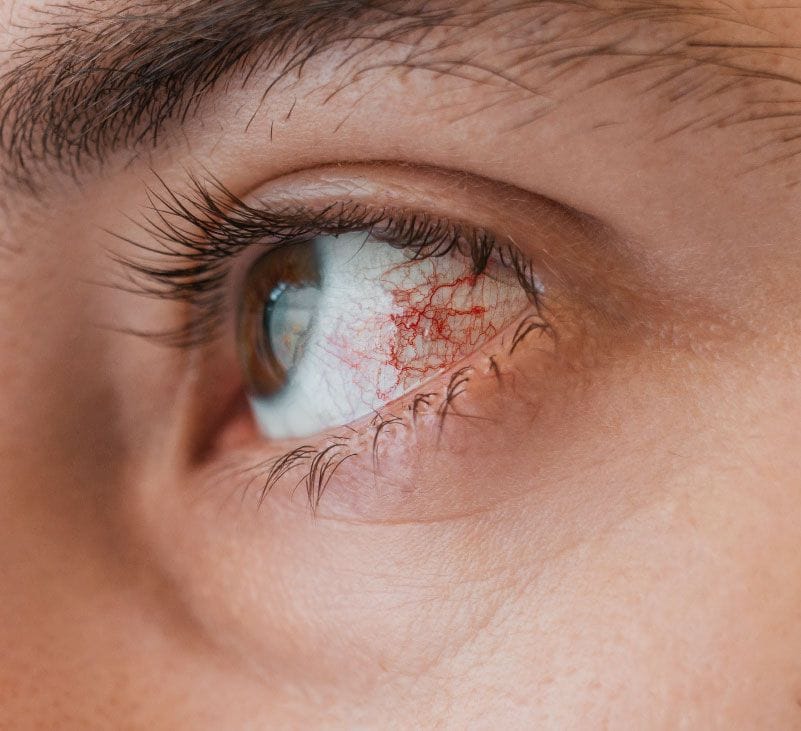
Conjunctivitis, commonly known as pink eye, is a highly contagious eye infection that affects the conjunctiva, the thin Reviewed by Experts transparent tissue that covers the white part of the eye and lines the inside of the eyelids. In Ayurveda, eye flu is referred to as “Netra Abhishyanda”. [1] [2] In this blog post, we will explore the symptoms, causes, treatment options, and preventive measures for conjunctivitis.
Conjunctivitis (eye flu) Symptoms:
Conjunctivitis presents several symptoms that can vary depending on the type and severity of the infection. The common signs and symptoms include:
Redness and Irritation
One of the most noticeable symptoms of conjunctivitis is the redness and irritation of the eyes. The affected eye(s) may appear bloodshot or swollen. [3] [4]
Watery Discharge
Conjunctivitis often causes a watery discharge from the eye(s). In some cases, the discharge may be thick and yellowish or greenish, indicating a bacterial infection. [3] [4]
Itching and Burning Sensation
Itchy and burning eyes are common symptoms of conjunctivitis. The urge to rub the eyes can further aggravate the condition and spread the infection. [3] [4]
Gritty Sensation
Many individuals with conjunctivitis experience a gritty or sandy feeling in the eyes. It may give the sensation of having a foreign object present. [3] [4]
Sensitivity to Light
Conjunctivitis can make the eyes sensitive to light, causing discomfort when exposed to bright lights or sunlight.[3] [4]
Causes of Conjunctivitis
It can have several causes, including:
Bacterial Infection
Bacterial eye infection is caused by various bacteria, such as Staphylococcus aureus, Streptococcus pneumoniae, or Haemophilus influenzae. It can be spread through direct contact with contaminated hands, towels, or eye makeup. [5]
Viral Infection
Viral conjunctivitis is primarily caused by adenoviruses, which are highly contagious. It spreads through direct contact with infected individuals or contaminated surfaces. [5]
Allergic Reaction
Allergic conjunctivitis occurs when the conjunctiva reacts to allergens such as pollen, pet dander, dust mites, or certain medications. It is not contagious and often affects both eyes. [5]
Irritants
Exposure to irritants such as smoke, chemicals, or chlorine in swimming pools can also lead to conjunctivitis. This type of eye flu is non-infectious and typically resolves once the irritant is removed. [5]
Treatment Options
Home Care:

1. Cleanliness: Proper hygiene is essential to prevent the spread of conjunctivitis. Wash hands frequently, avoid touching or rubbing the eyes, and use clean towels and pillows. [6] [7]
2. Warm Compress: Applying a warm compress to the affected eye(s) can help relieve discomfort and reduce swelling. Use a clean, warm washcloth and gently place it over the closed eyelids for a few minutes. [6] [7]
3. Eye Drops: Over-the-counter artificial tears or lubricating eye drops can provide temporary relief from dryness and discomfort associated with eye flu. Make sure to choose preservative-free drops. [6] [7]
Conjunctivitis Ayurvedic Treatment:
Ayurveda, the ancient Indian system of medicine, offers natural remedies and therapies for It. Some of the common Ayurvedic treatments include:
1. Triphala Eye Wash: Triphala, a combination of three fruits, is known for its antimicrobial and anti-inflammatory properties. Prepare a triphala eye wash by boiling one teaspoon of Triphala powder in a cup of water. After cooling, strain the solution and use it to rinse the eyes several times a day. [8]
2. Rose Water Compress: Rose water has soothing and cooling effects on the eyes. Soak cotton pads or a clean cloth in chilled rose water and place them over closed eyelids for 10-15 minutes. This can help reduce inflammation and provide relief in eye infection. [9]
3. Ayurvedic Eye Drops: Ayurvedic eye drops containing ingredients like neem, tulsi, or honey can be beneficial in reducing symptoms associated with conjunctivitis. These natural ingredients have antimicrobial and anti-inflammatory properties. [10]
4. Aloe Vera Gel: Applying fresh aloe vera gel around the eyes can help soothe irritation which might reduce redness. Ensure the gel is pure and free from additives or fragrances.[11]
Conjunctivitis Medical Treatment:
1. Antibiotic Eye Drops or Ointments: Bacterial eye infection is often treated with antibiotic eye drops or ointments to clear the infection. It is important to follow the prescribed dosage and duration for complete recovery. [6] [7]
2. Antiviral Medications: Viral eye flu does not respond to antibiotics. In some cases, antiviral medications may be prescribed to alleviate symptoms and shorten the duration of the infection. [6] [7]
3. Allergy Medications: Allergic conjunctivitis can be managed with over-the-counter or prescription allergy medications, such as antihistamines or mast cell stabilizers. These medications help reduce inflammation and relieve symptoms. [6] [7]
4. Steroid Eye Drops: In severe cases of eye flu, steroid eye drops may be prescribed to reduce inflammation and alleviate symptoms. However, these medications should only be used under the supervision of a healthcare professional due to potential side effects. [6] [7]
Conjunctivitis Prevention and Precautions
Preventing the spread of conjunctivitis or eye flu is crucial to protect yourself and others. Here are some preventive measures to consider:
Hand Hygiene
Wash your hands frequently with soap and water, especially after touching your eyes or coming into contact with potentially contaminated surfaces. [12] [13]
Avoid Touching Eyes
Refrain from touching or rubbing your eyes, as this can increase the risk of spreading the infection. [12] [13]
Personal Items
Avoid sharing personal items such as towels, washcloths, or cosmetics with others, as these can harbour bacteria or viruses. [12] [13]
Proper Contact Lens Care
If you wear contact lenses, follow proper hygiene practices. Clean and disinfect your lenses according to the instructions provided by your eye care professional. [12] [13]
Allergen Avoidance
If you have allergic conjunctivitis, identify and avoid triggers such as pollen, pet dander, or dust mites. Use air purifiers and keep your living space clean to minimize allergen exposure. [12] [13]
FAQs
1. Is conjunctivitis (eye flu) contagious?
Yes, conjunctivitis can be highly contagious, especially the viral and bacterial types. It can spread through direct contact with infected individuals, contaminated surfaces, or sharing personal items.
2. How is conjunctivitis diagnosed?
It is typically diagnosed through a physical examination of the eyes and a review of symptoms by a healthcare professional. In some cases, additional tests or laboratory analysis may be required.
3. Can I treat conjunctivitis (eye flu) at home?
Home care measures can help alleviate the symptoms of conjunctivitis. These include maintaining good hand hygiene, applying warm compresses to the eyes, using over-the-counter eye drops, and avoiding rubbing or touching the eyes, however if symptoms persist please contact a Physician.
4. When should I seek medical treatment for conjunctivitis?
It is advisable to seek medical treatment for eye flu if you experience severe symptoms, persistent discomfort, worsening of symptoms, or if the condition does not improve within a few days.
5. Can I wear contact lenses if I have conjunctivitis?
It is generally recommended to avoid wearing contact lenses until the eye flu has completely resolved. Contact lens wearers should follow their eye care professional’s guidance and instructions for safe and hygienic lens use.
Conclusion
Conjunctivitis, or pink eye, or eye flu is a common eye infection that can cause redness, irritation, and discharge. By practising good hygiene, taking preventive measures, and seeking timely treatment, you can effectively manage conjunctivitis and minimize its impact on your eye health. Remember, if you experience persistent or worsening symptoms, consult an eye care professional for proper evaluation and guidance.
Disclaimer: This article is only for providing a medical and general knowledge perspective and does not constitute medical advice. Kindly seek the help of a trained medical practitioner before initiating any treatment.
References:
- Conjunctivitis – PMC (nih.gov)
- A-Clinical-Study-On-The-Effect-Of-Rasanjana-Extract-Of-Berberis-Aristata-Eye-Drops-In-Treatment-Of-Netra-Abhishyanda-Infective-Conjunctivitis (researchgate.net)
- Signs and Symptoms of Pink Eye (Conjunctivitis) | CDC
- Conjunctivitis – StatPearls – NCBI Bookshelf (nih.gov)
- Causes of Pink Eye (Conjunctivitis) | CDC
- Treating Pink Eye (Conjunctivitis) | CDC
- Conjunctivitis: A Systematic Review of Diagnosis and Treatment | Allergy and Clinical Immunology | JAMA | JAMA Network
- Optimization of Parisheka kriyakalpa (procedure for closed eye irrigation) 3: A clinical study on acute conjunctivitis with Triphala decoction(nopr.niscpr.res.in)
- Ayurvedic Drugs Used In Eye Disorder-A Review | International Journal of Recent Scientific Research
- A Systemic Review of Ocimum sanctum (Tulsi): Morphological Characteristics, Phytoconstituents and Therapeutic Applications | International Journal for Research in Applied Sciences and Biotechnology (ijrasb.com)
- Aloe vera their chemicals composition and applications: A review (researchgate.net)
- Help Protect Yourself from Pink Eye Infographic | CDC
- Preventing Pink Eye (Conjunctivitis) | CDC





















